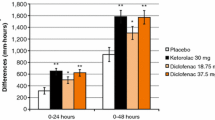Abstract
A novel formulation of diclofenac sodium suitable for subcutaneous or intramuscular injection (Akis®, Dicloin®) has been developed using the complexing agent hydroxypropyl-β-cyclodextrin (HPβCD) as a solubility enhancer. Diclofenac HPβCD is available in several European countries, where it is indicated for use in adults with acute forms of pain, including postoperative pain. Clinical trials have demonstrated the analgesic efficacy of diclofenac HPβCD in terms of relieving moderate to severe postoperative pain in patients undergoing dental surgery or minor orthopaedic surgery. Subcutaneous diclofenac HPβCD also effectively relieved moderate to severe neuropathic pain, related to cancer or not. Diclofenac HPβCD was generally well tolerated in clinical trials, with injection-site reactions among the most commonly reported adverse events. The local tolerability of diclofenac HPβCD was consistently rated as ‘good’ or ‘excellent’ across all studies. Subcutaneous administration of diclofenac is a valid alternative to intramuscular delivery, with the advantages of easier administration, the availability of additional body sites suitable for injection and the potential for self-administration. Thus, diclofenac HPβCD 25, 50 or 75 mg/mL solution for subcutaneous or intramuscular injection extends the treatment options available for use in the management of pain in adults.
Similar content being viewed by others
References
Moore RA, McQuay HJ, Derry P, et al. Single dose oral diclofenac for acute postoperative pain in adults. Cochrane Database Syst Rev. 2004(2):CD004768.
McCormack PL, Scott LJ. Diclofenac sodium injection (Dyloject ®): in postoperative pain. Drugs. 2008;68(1):123–30.
Leeson RM, Harrison S, Ernst CC, et al. Dyloject, a novel injectable diclofenac formulation, offers greater safety and efficacy than Voltarol for postoperative dental pain. Reg Anesth Pain Med. 2007;32(4):303–10.
Medicines and Healthcare products Regulatory Agency. Public assessment report Akis 25, 50, 75 ng/mL solution for injection. 2015. http://www.mhra.gov.uk/home/groups/par/documents/websiteresources/con239402.pdf. Accessed 8 May 2015.
Gan TJ. Diclofenac: an update on its mechanism of action and safety profile. Curr Med Res Opin. 2010;26(7):1715–31.
Medicines and Healthcare products Regulatory Agency. Akis: summary of product characteristics. 2015. http://www.mhra.gov.uk. Accessed 8 May 2015.
National Health and Medical Research Council. Acute pain management: scientific evidence. 2010. https://www.nhmrc.gov.au/_files_nhmrc/publications/attachments/cp104_3.pdf. Accessed 8 May 2015.
Carr DB, McDonnell Moorehead T, Bouchard A, et al. Effects of injectable HPβCD-diclofenac on the human delayed rectifier potassium channel current in vitro and on proarrhythmic QTc in vivo. Clin Ther. 2013;35(5):646–58.
Zeitlinger M, Rusca A, Oraha AZ, et al. Pharmacokinetics of a new diclofenac sodium formulation developed for subcutaneous and intramuscular administration. Int J Clin Pharmacol Ther. 2012;50(6):383–90.
Salomone S, Piazza C, Vitale DC, et al. Pharmacokinetics of a new subcutaneous diclofenac formulation administered to three body sites: quadriceps, gluteus, and abdomen. Int J Clin Pharmacol Ther. 2014;52(2):129–34.
Dietrich T, Leeson R, Gugliotta B, et al. Efficacy and safety of low dose subcutaneous diclofenac in the management of acute pain: a randomized double-blind trial. Pain Pract. 2014;14(4):315–23.
IBSA Institut Biochimique SA. Evaluation of the efficacy and safety of diclofenac HPBCD 75 mg/ml in treatment of pain following dental surgery [ClinicalTrials.gov identifier NCT00943098] US National Institutes of Health, ClinicalTrials.gov. 2012. https://clinicaltrials.gov/ct2/show/NCT00943098. Accessed 8 May 2015.
Chiarello E, Bernasconi S, Gugliotta B, et al. Subcutaneous injection of diclofenac for the treatment of pain following minor orthopedic surgery (DIRECT study): a randomized trial. Pain Pract. 2015;15(1):31–9.
IBSA Institut Biochimique SA. Evaluation of the efficacy and safety of diclofenac HPBCD 25, 50 mg/ml in the treatment of post-surgical pain following dental surgery [ClinicalTrials.gov identifier NCT00942448] US National Institutes of Health, ClinicalTrials.gov. 2012. https://www.clinicaltrials.gov/ct2/show/NCT00942448. Accessed 8 May 2015.
Amato F, Morrone EG, Lacquaniti G. Efficacy, safety and tolerance of subcutaneous injection of high dosages of diclofenac in patients with neuropathic non-cancer pain and neuropathic cancer pain: data from a clinical setting. Eur J Inflamm. 2015;13(1):32–9.
White PF. The role of non-opioid analgesic techniques in the management of pain after ambulatory surgery. Anesth Analg. 2002;94(3):577–85.
National Pharmaceutical Council. Pain: current understanding of assessment, management, and treatments. 2001. http://www.npcnow.org/system/files/research/download/Pain-Current-Understanding-of-Assessment-Management-and-Treatments.pdf. Accessed 8 May 2015.
Hall E. Subcutaneous diclofenac: an effective alternative? Palliat Med. 1993;7:339–40.
Prettyman J. Subcutaneous or intramuscular? Confronting a parenteral administration dilemma. Medsurg Nurs. 2005;14(2):93–9.
IBSA Institut Biochimique SA. Clinical study report 09PUK/DCsc05. Lugano: IBSA Institut Biochimique SA, 2010 (Data on file).
Disclosure
The preparation of this review was not supported by any external funding. During the peer review process, the manufacturer of the agent under review was offered an opportunity to comment on this article. Changes resulting from comments received were made by the authors on the basis of scientific and editorial merit. Hannah Blair and Greg Plosker are salaried employees of Adis/Springer.
Author information
Authors and Affiliations
Corresponding author
Additional information
The manuscript was reviewed by: A. L. Kovac, Department of Anesthesiology, University of Kansas Medical Center, Kansas City, KS, USA; H. G. Kress, Department of Special Anaesthesia and Pain Therapy, Medical University of Vienna, Vienna, Austria; S. Salomone, Department of Biomedical and Biotechnological Sciences, Catania University, Catania, Italy.
Rights and permissions
About this article
Cite this article
Blair, H.A., Plosker, G.L. Diclofenac Sodium Injection (Akis®, Dicloin®): A Review of Its Use in the Management of Pain. Clin Drug Investig 35, 397–404 (2015). https://doi.org/10.1007/s40261-015-0294-6
Published:
Issue Date:
DOI: https://doi.org/10.1007/s40261-015-0294-6




